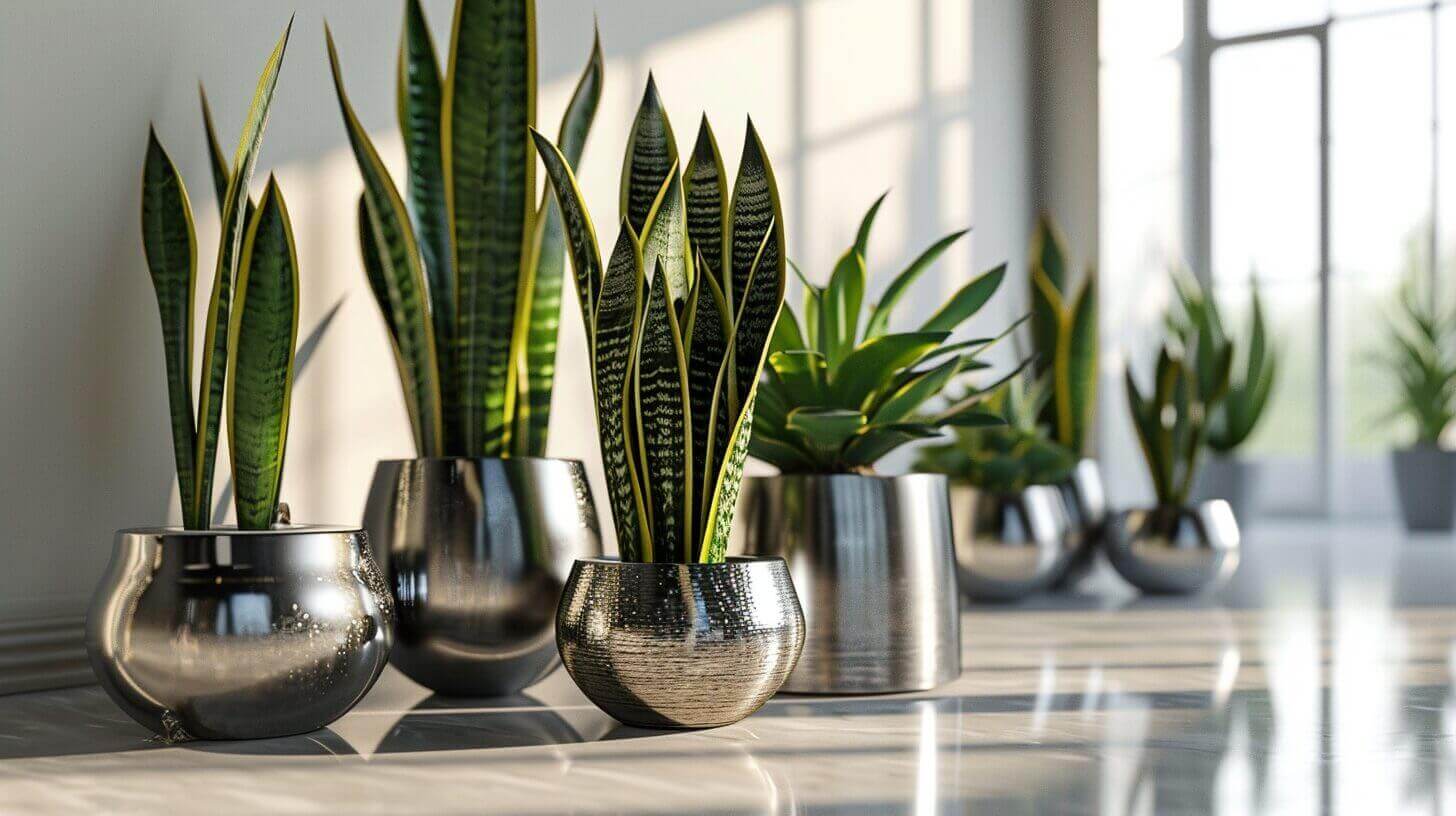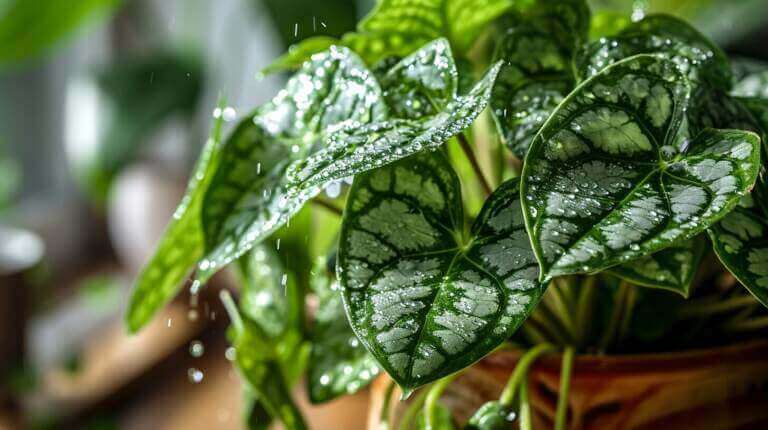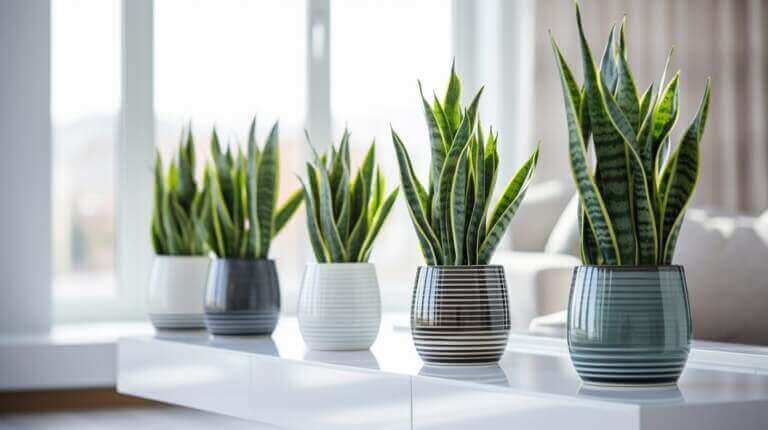Just Exactly How Much Light Does a Snake Plant Need?
Unlock the Secrets of Snake Plant Care: Shedding Light on the Ideal Conditions
Are you navigating the maze of snake plant care, trying to decipher its light needs? The quest for the perfect spot for your beloved sansevieria can feel like an exciting puzzle. Fear not, for we’re here to illuminate your path to success.
In this engaging guide, we’ll demystify snake plant care and unveil the secrets to achieving optimal light levels for your cherished Sansevieria. Let’s embark on this enlightening journey together.
Key Takeaways
- Snake plants thrive in bright, indirect light but can tolerate low-light conditions.
- East or west-facing windows provide the right morning or afternoon sunlight for snake plants.
- If natural light is insufficient, supplement it with full-spectrum grow lights about 12 inches above the plant.
- Avoid exposing snake plants to intense or direct sunlight for extended periods to prevent leaf burn.
Understanding the Light Requirements of Snake Plants
When determining the ideal placement for your snake plant, it is crucial to understand the light requirements that this particular species thrives in. Snake plants, also known as Sansevieria, are known for their ability to tolerate a wide range of light conditions. However, they do best in bright, indirect light. Maximizing growth and ensuring the health of your snake plant requires finding the perfect balance of light.
Snake plants can tolerate low light conditions but will not thrive in such environments. The plant’s growth may slow down in low light, and the leaves may become less vibrant. If your snake plant is not receiving enough light, there are a few troubleshooting steps you can take. First, try moving it to a brighter location, such as near a window with filtered light. If that is not possible, consider using artificial grow lights to supplement the natural light.
On the other hand, snake plants can also tolerate bright, direct light, but too much intense sunlight can cause the leaves to burn. If your snake plant is exposed to direct sunlight, providing some shade or moving it to a spot with filtered light is recommended.
Understanding the light requirements of your snake plant is essential for maximizing its growth and ensuring its overall health. By troubleshooting low light conditions and finding the perfect balance of light, you can create an environment where your snake plant can thrive.
Assessing the Natural Light in Your Home
To determine the ideal placement for your snake plant, it is important to assess the natural light in your home, ensuring it meets the species’ light requirements. Evaluating sunlight exposure is crucial in choosing appropriate lighting for your snake plant.
Snake plants, known as Sansevieria, thrive in medium to bright indirect light. They can tolerate low light conditions, but their growth may be slower. On the other hand, too much direct sunlight can cause their leaves to burn. Therefore, finding the perfect balance is key.
Start by observing the different areas of your home that receive sunlight throughout the day. Note the intensity and duration of the light in each spot. Snake plants generally require at least four hours of indirect sunlight each day. East or west-facing windows are ideal, as they provide the right amount of morning or afternoon sunlight.
If your home lacks sufficient natural light, you can supplement it with artificial lighting. Choose full-spectrum grow lights specifically designed for plants. Position the lights about 12 inches above them and keep your snake plant them on for 12 to 14 hours a day.
Identifying the Best Indoor Spots for Your Snake Plant
One of the most important considerations in identifying the best indoor spots for your snake plant is ensuring it receives at least four hours of indirect sunlight daily. Snake plants, also known as Sansevieria, are known for their ability to thrive in low-light conditions, but they still require some exposure to sunlight to stay healthy.
Placing your snake plant near a north or east-facing window is ideal, as these directions provide the right amount of indirect sunlight without exposing the plant to intense, direct rays.
In addition to light, another key factor in snake plant care is watering. Snake plants prefer to be on the drier side, so it’s important not to overwater them. The ideal watering schedule for a snake plant is to allow the soil to dry out between waterings. This prevents the roots from becoming waterlogged and helps prevent the risk of root rot.
Once you have found the perfect spot for your snake plant and have mastered the art of watering, you may also consider propagating your snake plant. Snake plant propagation is relatively easy and can be done by dividing the plant or using leaf cuttings. This allows you to expand your collection or share the joy of snake plants with friends and family.
In the next section, we will discuss how to adjust the light levels for optimal snake plant growth, ensuring that your plant thrives and continues to bring beauty and benefits to your indoor space.
Adjusting Light Levels for Optimal Snake Plant Growth
The adjustment of light levels is crucial for achieving optimal snake plant growth and ensuring the plant’s health and vitality. Whether you are using sunlight or artificial light, it is essential to understand how to adjust the light intensity to meet the needs of your snake plant. Here are four important factors to consider when adjusting the light levels for your sansevieria:
- Intensity: Snake plants thrive in bright, indirect light. Too much direct sunlight can scorch the leaves, while insufficient light can result in leggy growth and a lack of vibrancy.
- Duration: Snake plants require approximately 6-8 hours of light per day. However, it is important to avoid exposing them to light for extended periods without any breaks, as this can lead to stress and potential damage.
- Consistency: Maintaining a consistent light schedule is essential for the health of your snake plant. Sudden changes in light levels can disrupt the plant’s growth and even cause it to shock.
- Light Source: Snake plants can adapt to different light sources, but natural sunlight is generally preferred. If using artificial light, choose a full-spectrum bulb that closely mimics natural sunlight to provide the necessary wavelengths for photosynthesis.
By carefully adjusting the light levels for your snake plant, you can create an environment that promotes healthy growth and ensures the plant’s overall well-being.
Now that we understand the importance of adjusting light levels let’s explore some common mistakes to avoid when providing light for your sansevieria.
Common Mistakes to Avoid When Providing Light for Your Sansevieria
During the process of providing light for your sansevieria, it is vital to avoid common mistakes that can hinder the plant’s growth and overall health. One of the most common mistakes is underestimating the importance of light intensity. Sansevierias thrive in bright, indirect light, but too much direct sunlight can scorch their leaves. On the other hand, insufficient light can cause the plant to become weak and leggy.
To avoid these mistakes, finding the perfect spot for your sansevieria is important. Ideally, place the plant near a window that receives bright, indirect light for most of the day. If you have limited natural light, you can supplement it with artificial light sources such as fluorescent or LED grow lights. However, be cautious not to expose the plant to intense or direct light for extended periods, as it can damage the leaves.
Another mistake to avoid is not providing consistent light. Sansevierias thrive in a consistent light environment, so avoid moving them around too frequently. Sudden changes in light conditions can shock the plant and disrupt its growth.
FAQ on Snake Plant Care Guide
Does the Watering Frequency of a Snake Plant Depend on the Amount of Light it receives?
The watering frequency for snake plants does not depend on the amount of light they receive. Snake plants are highly adaptable and drought-tolerant, making them suitable for low light conditions. It is crucial to allow the soil to dry out between waterings to prevent overwatering, regardless of the light conditions.
Does the Amount of Light Affect the Repotting Process of a Snake Plant?
Repotting snake plants has no impact on their light requirements. These hardy indoor plants can tolerate various lighting conditions, ranging from low to bright light. It is essential to determine when to repot snake plants based on their rootbound condition rather than light preferences. Repotting should be done when the plant outgrows its current container or shows signs of root congestion.
Can Snake Plants Survive in Low-Light Conditions Without Any Natural Light?
Snake plants can survive in low-light conditions, making them suitable for dark corners. To care for snake plants in such environments, snake plants grow best in indirect light, avoid overwatering, and ensure proper drainage to prevent root rot.
Do Snake Plants Require Direct Sunlight to Thrive, or Can They Tolerate Indirect Light?
Snake plants, also known as Sansevieria, can tolerate both direct sunlight and indirect light. While they can thrive in well-lit areas, they are also adaptable to lower light conditions, making them a versatile and low-maintenance choice for indoor plants. These well-liked indoor houseplants thrive in any light level, from low to high. These well-liked indoor houseplants grow more quickly in bright light, but direct sunlight will burn leaves, especially when plants are outdoors without shade.
Can I Use Artificial Light Sources, Such as Grow Lights, to Provide Sufficient Light for My Snake Plant?
Using grow lights for snake plants can provide sufficient light, especially in low-light conditions. However, it is important to consider the pros and cons of using artificial light, such as the cost, energy consumption, and potential for overexposure.
Are There Any Specific Light Requirements for Different Varieties of Snake Plants, or Do They All Have Similar Needs?
Different varieties of snake plants may have specific light requirements due to factors such as their natural habitat and leaf coloration. Understanding these requirements is crucial for providing optimal light conditions to ensure the plant’s health and growth.
How much light does a snake plant need?
Snake plants (Sansevieria) are known for their ability to thrive in a wide range of lighting conditions. They can tolerate low light but prefer bright, indirect light. Ideally, they should be placed where they can receive bright, indirect light for a few hours each day.
What are the signs that my snake plant is not getting enough light?
If your snake plant is not getting enough light, you may notice that its leaves become pale or yellow in color. The plant may also become leggy and stretched out. Additionally, it may not grow as quickly as it should.
Can a snake plant survive without sunlight?
While snake plants prefer bright, indirect light, they can survive in low light conditions. They are often recommended as low-light houseplants. However, if you want your snake plant to grow quickly and thrive, it is best to provide it with bright light.
How much light does a snake plant need to grow?
Snake plants need about 8-10 hours of bright, indirect light per day to grow properly. They can tolerate low indoor light, but their growth will be slower. If you have a snake plant that doesn’t receive enough light, try moving it closer to a window or providing it with supplemental artificial light.
Can snake plants grow in low light conditions?
Yes, snake plants can grow in low light conditions. They are known for being able to tolerate a wide range of light conditions. However, their growth will be slower in low light, and they may become leggy. If you want your snake plant to grow faster, it is best to provide it with bright, indirect light.
Can a snake plant survive without sunlight?
While snake plants can tolerate low light conditions, they still need some amount of light to survive and thrive. Without any light, the plant will not be able to photosynthesize and produce energy. Therefore, it is important to provide your snake plant with at least some indirect light to ensure its health and growth.
Can snake plants tolerate direct light?
While snake plants can tolerate some amount of direct light, it is generally not recommended to expose them to intense direct sunlight for extended periods of time. Direct sunlight can burn the leaves of the plant and cause damage. It is best to provide snake plants with bright, indirect light instead.
What are the reasons why my snake plant leaves are turning yellow?
The most common reason for snake plant leaves turning yellow is a lack of light. If your snake plant is not receiving enough light, the leaves may lose their green color and turn yellow. Other possible causes include overwatering, poor drainage, or root rot. Ensure that your snake plant is getting enough light, water it appropriately, and check the soil moisture levels to address these potential issues.
How do I know if my snake plant isn’t getting enough light?
There are a few signs that indicate your snake plant isn’t getting enough light. In addition to the leaves turning pale or yellow, you may notice slow or stunted growth, smaller leaves, or a general lack of vibrancy in the plant’s overall appearance. If you observe these signs, it’s a good idea to move your snake plant to a brighter spot.







